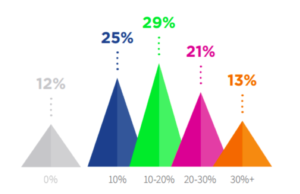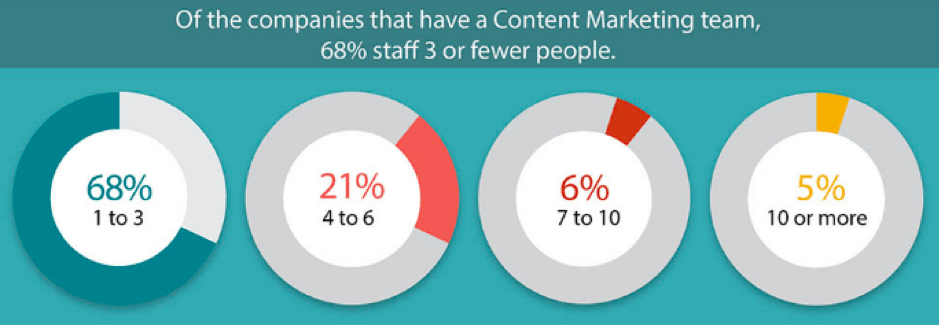When it comes to content marketing, there’s always lots of information floating around…most of it contradictory. One expert says this; another says that it is any wonder marketers feel perpetually lost in the weeds.
In this post, we’re giving you the facts and nothing but the facts. These statistics are going to help you paint of picture of what’s going on when it comes to what’s working with content marketing in 2018.
If you’re ready for your daily influx of charts, graphs, and stats, it’s time to dive in!
B2B Content Marketing Statistics
In the B2B market, content marketing is becoming increasingly important. Brands are using it to attract their customers and engage with them through a variety of channels, such as blogging, email, and social media.
- According to a Content Marketing Institute B2B Content Marketing Study, 91% of responding brands use content marketing as part of their strategy.

- And of those respondents in the same study, 65% said their overall content marketing success had increased since one year ago.
- A 2017 B2B Content Preferences Survey by Demand Gen found that “47% of buyers rely more on content to research and make B2B purchasing decisions.”
- The same report highlighted the type of content other B2B buyers would like to see from other brands to help them in their buying decisions.

- It’s also essential for B2B brands to be mobile-friendly with their content, with a study finding that 54% of respondents preferred content that was mobile-optimized so it could be accessed via smartphones and tablets.
- Forrester found that 72% of the marketers they surveyed have less than half of their marketing staff playing essential roles in content marketing; 87% of them also say they are struggling to produce content that is engaging buyers.
- Demand Gen also found that B2B buyers are looking at a variety of content when making buying decisions.
- B2B brands that understand this struggle are spending more time focusing on strategy and the buyer’s journey. Regalix found that “Understanding the customer journey (78%) and mapping the right content asset to each stage of that journey (77%) were the outright winners in the list of capabilities that marketers felt were very important to the success of their initiatives over the next three years.”
- The Content Marketing Institute not only found that a better strategy was an important factor in the success of B2B respondents but also focused on creating better and more effective content over more content.
Blogging Statics
Speaking of creating better content, blogging is still a huge factor. The strategies that worked five years ago are falling flat today. So, check out some of the statistics to see what is working in 2018 and into the future.
- Hubspot’s State of Inbound 2018 found that, by a pretty significant margin, marketers cited generating traffic and leads are their top challenges.

- Hubspot has also highlighted that “55% of marketers say blog content creation is their top inbound marketing priority.”
- Of course, it should go without saying that blogging can have a massive impact on SEO. Both B2B and B2C brands that have blogs see more links, leads, and indexed pages than their counterparts who do not blog. [source]

- Content is getting longer, which highlights how more detailed and in-depth content is focused on educating readers. “…the content on URLs near the top of the search results is becoming more detailed, more holistic and therefore better able to answer more user questions.”

- Better content is valuable because more and more people are experiencing content shock online. So average content is now seeing limited success with readers. In 2016, there were 1,440 WordPress posts created every 60 seconds. [source]
- Content that is less than 1,000 words get fewer shares and links than longer content. [source]
- Content marketers are spending more time on original research, and blogs are the top content being created to highlight this research, according to MarketingProfs.

- In their survey, Ion Interactive found that “Just over half (51%) of business owners report that content management is “very important” or “absolutely critical” to creating a cohesive customer journey.”
- It turns out that updating old content matters. Orbit Media found that only 55% of bloggers update their own content.
- But bloggers that do are “74% more likely to report strong results.” [source]
Content Marketing Strategy Statistics
Building an effective strategy has become a huge part of content marketing. It’s no longer enough to write a post and schedule a few tweets and wait for the fans to come running. Now, brands and bloggers alike must have an effective strategy in place when it comes to content marketing.
Here’s the good news.
- CMI’s B2C survey found that 86% of respondents use content marketing.

So while so many marketers are using content marketing, results are still mixed.
The Havas Group found three facts that stood out around content marketing strategies in their 2017 Meaningful Brands Index:
- “84% of people expect brands to create content that provides solutions, experiences, entertainment, and events.”
- However, “60% of all content created by brands is poor, irrelevant, or fails to deliver.”
- And the most devastating result, “consumers wouldn’t care if 74% of the brands they use just disappeared.”
- In a B2C study, CMI found that only 38% of marketers who have a content marketing strategy document it.
- Marketers are using a number of content strategies to improve their inbound marketing success:

- According to Curata, 37% of marketers never perform a blog audit.
Clearly, there is still a lot of low-hanging fruit that marketers can attack to improve their measurable results when it comes to tracking content marketing.
- And successful marketers highlight that they do look to their content to reuse and repurpose it:

[source]
- Here’s some good news for freelancers, 62% of B2C marketing respondents outsource, with almost 50% outsourcing content creation. [source]
Content Marketing ROI Statistics
So can you find some real, measurable results from a content strategy? Yes, you can. These stats highlight how marketers are seeing some real benefits from their content marketing over the last few years.
- Curata found that “74% of companies are increasing lead quality & quantity from content.”
- Over 50% of marketers found they see the highest ROI from inbound marketing tactics and strategies.

- Content Marketing Institute found that 43% of B2C marketers measure the ROI of their content marketing efforts.
- And according to the same study, of those marketers who don’t measure their content marketing ROI, the biggest struggle was a lack of ease; 45% cited “we need an easier way to do this.”
- Email marketing has the best ROI of any other channel. [source]
- Dollar for dollar, content marketing generates more leads than other types of marketing.

Video and Interactive Marketing Statistics
The written word is no longer the only game in town when it comes to content that is making a splash. Now, and it looks like in the future, video marketing is making a significant impact as a growing part of an effective content marketing strategy.
- Social Media Examiner asked marketers the single most important form of content for their business.

So it’s not a massive surprise that Video is becoming increasingly popular. You can see this in the next stat.
- The same study from SME also found that 77% of marketers plan to increase their use of video, and 63% said they plan to increase their use of live videos. Both of these types of videos were also cited as the #1 and #2 areas of marketing that marketers would like to learn more about, respectively.
- “51.9% of marketing professionals worldwide name video as the type of content with the best ROI.” [source]
- Content marketers are increasingly using short videos to reach consumers:

[source]
Interactive content is poised to explode in the coming years, and marketers already see some fascinating data points around the potential.
- Kapost found that “Interactive content generates 2x more conversions than passive content.”
- In their survey, GO-Gulf found a number of reasons why interactive content is being used:

Ion Interactive has been able to compile a ton of information on interactive content and how it impacts both brands and consumers. Some of these findings include:
- “Interactive content does a much better job of educating the buying audience, as 93% of study participants reported interactive content as somewhat or very effective in this role.”
- “79% agree that interactive content results in repeat visitors and multiple exposures.”
- “88% of marketers said that interactive content is effective in differentiating their brand from their competitors.”
- In a DemandGen report, almost 90% of B2B marketers are going to be increasing their interactive content marketing in the next 12-24 months.

Content Marketing Budget Statistics
It’s tough to succeed when it comes to content marketing if you don’t have the budget to make it happen. The process today doesn’t come cheap, and brands have to spend funds to see results.
- Most brands don’t have a large team centered around creating content and performing content marketing.

[source]
- “37% of all respondents said they expect their organization’s content marketing budget to increase in the next 12 months.” [source]
- In a Demand Metric survey, they found that content marketing costs less than traditional marketing.

- The same survey found that “78 percent of CMOs are investing in custom content.”
- Curata found that a “limited budget (including staff)” was the most significant content marketing challenge for marketers.
- In 2018, 61% of the marketing budget will be spent on content creation, according to Statista.
Content Marketing Predictions
So what’s going to happen with content marketing beyond 2018?
We’ve compiled a few influencers who got out their crystal ball and shared some of their predictions on what’s happening in the industry.
As you saw from the stats above, the brands that are standing out now are those that are investing in creating content that is interesting and different. That’s what makes brands stand out today.
“As content marketing becomes more mature, brands, agencies, and publishers will put more effort into creating content that differentiates, stands out, and is focused on creating value for the reader.” – Stephanie Stahl [source]
Another important focus has to be on customer needs. Content marketers who have a strategy that plans around moving customers through the funnel while focusing on building relationships are going to win over the long run.
“More marketers are spending time thoughtfully creating a brand voice that speaks to customers, which develops relationships rooted in trust.” – Shafqat Islam [source]
The focus might be the name of the game going forward. It’s often really tempting to be everything to everyone online. Still, creating content your ideal customers love and posting it where they hang out might actually be your best strategy overall.
“While so many brands get a story idea and decide to publish everywhere, the strategy that works the best is the true focus. Communicate your message through one content type (audio, video, textual, imagery) and one main platform (website, YouTube, iTunes). Deliver consistently over a long timeframe (12 months or more). This is how great media brands and loyal audiences are built; there is no better way.” – Joe Pulizzi [source]
Final Thoughts
Well, there you have it. Hopefully, after going through these stats and predictions, you’re going to have a good idea of where you should put your content marketing efforts going forward.
Editor’s Note: Liz Froment is a Boston-based writer who helps create content and copy for B2B brands that drive conversions. Her areas of expertise include real estate, finance, digital marketing, mobile marketing, entrepreneurship, and technology (including SaaS). To learn more about Liz or to have her write for your brand, sign up for nDash today!


